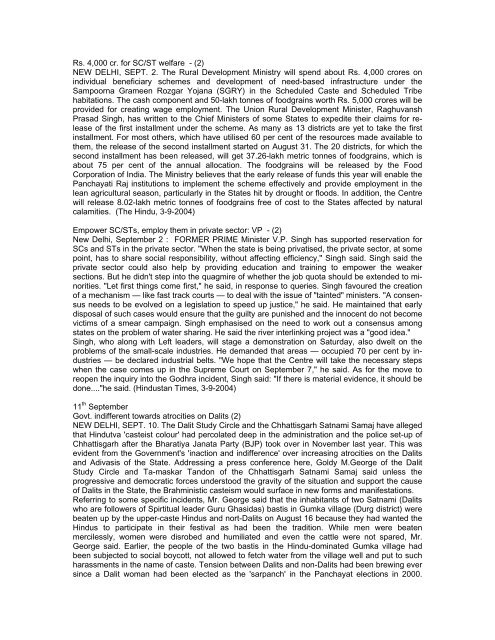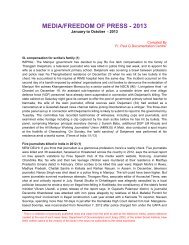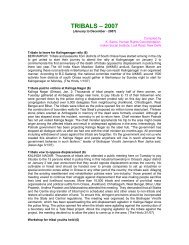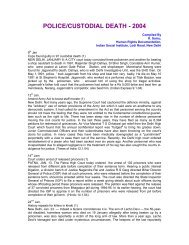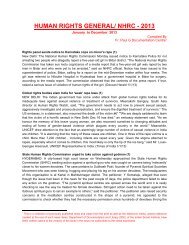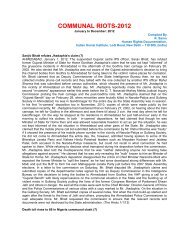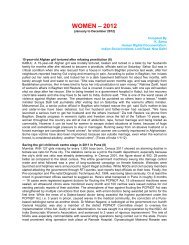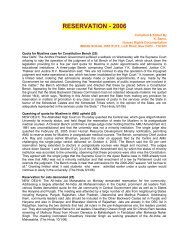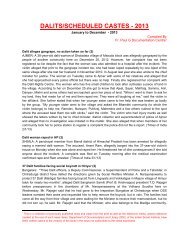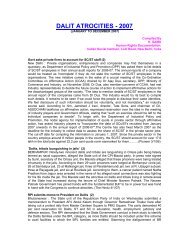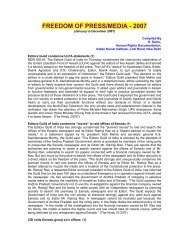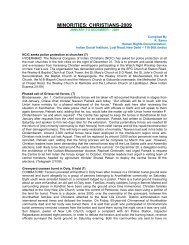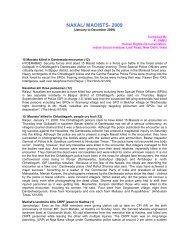DALIT ATROCITIES IN INDIA - 2004 - Indian Social Institute
DALIT ATROCITIES IN INDIA - 2004 - Indian Social Institute
DALIT ATROCITIES IN INDIA - 2004 - Indian Social Institute
You also want an ePaper? Increase the reach of your titles
YUMPU automatically turns print PDFs into web optimized ePapers that Google loves.
Rs. 4,000 cr. for SC/ST welfare - (2)NEW DELHI, SEPT. 2. The Rural Development Ministry will spend about Rs. 4,000 crores onindividual beneficiary schemes and development of need-based infrastructure under theSampoorna Grameen Rozgar Yojana (SGRY) in the Scheduled Caste and Scheduled Tribehabitations. The cash component and 50-lakh tonnes of foodgrains worth Rs. 5,000 crores will beprovided for creating wage employment. The Union Rural Development Minister, RaghuvanshPrasad Singh, has written to the Chief Ministers of some States to expedite their claims for releaseof the first installment under the scheme. As many as 13 districts are yet to take the firstinstallment. For most others, which have utilised 60 per cent of the resources made available tothem, the release of the second installment started on August 31. The 20 districts, for which thesecond installment has been released, will get 37.26-lakh metric tonnes of foodgrains, which isabout 75 per cent of the annual allocation. The foodgrains will be released by the FoodCorporation of India. The Ministry believes that the early release of funds this year will enable thePanchayati Raj institutions to implement the scheme effectively and provide employment in thelean agricultural season, particularly in the States hit by drought or floods. In addition, the Centrewill release 8.02-lakh metric tonnes of foodgrains free of cost to the States affected by naturalcalamities. (The Hindu, 3-9-<strong>2004</strong>)Empower SC/STs, employ them in private sector: VP - (2)New Delhi, September 2 : FORMER PRIME Minister V.P. Singh has supported reservation forSCs and STs in the private sector. "When the state is being privatised, the private sector, at somepoint, has to share social responsibility, without affecting efficiency," Singh said. Singh said theprivate sector could also help by providing education and training to empower the weakersections. But he didn't step into the quagmire of whether the job quota should be extended to minorities."Let first things come first," he said, in response to queries. Singh favoured the creationof a mechanism — like fast track courts — to deal with the issue of "tainted" ministers. "A consensusneeds to be evolved on a legislation to speed up justice," he said. He maintained that earlydisposal of such cases would ensure that the guilty are punished and the innocent do not becomevictims of a smear campaign. Singh emphasised on the need to work out a consensus amongstates on the problem of water sharing. He said the river interlinking project was a "good idea."Singh, who along with Left leaders, will stage a demonstration on Saturday, also dwelt on theproblems of the small-scale industries. He demanded that areas — occupied 70 per cent by industries— be declared industrial belts. "We hope that the Centre will take the necessary stepswhen the case comes up in the Supreme Court on September 7," he said. As for the move toreopen the inquiry into the Godhra incident, Singh said: "If there is material evidence, it should bedone...."he said. (Hindustan Times, 3-9-<strong>2004</strong>)11 th SeptemberGovt. indifferent towards atrocities on Dalits (2)NEW DELHI, SEPT. 10. The Dalit Study Circle and the Chhattisgarh Satnami Samaj have allegedthat Hindutva 'casteist colour' had percolated deep in the administration and the police set-up ofChhattisgarh after the Bharatiya Janata Party (BJP) took over in November last year. This wasevident from the Government's 'inaction and indifference' over increasing atrocities on the Dalitsand Adivasis of the State. Addressing a press conference here, Goldy M.George of the DalitStudy Circle and Ta-maskar Tandon of the Chhattisgarh Satnami Samaj said unless theprogressive and democratic forces understood the gravity of the situation and support the causeof Dalits in the State, the Brahministic casteism would surface in new forms and manifestations.Referring to some specific incidents, Mr. George said that the inhabitants of two Satnami (Dalitswho are followers of Spirtitual leader Guru Ghasidas) bastis in Gumka village (Durg district) werebeaten up by the upper-caste Hindus and nort-Dalits on August 16 because they had wanted theHindus to participate in their festival as had been the tradition. While men were beatenmercilessly, women were disrobed and humiliated and even the cattle were not spared, Mr.George said. Earlier, the people of the two bastis in the Hindu-dominated Gumka village hadbeen subjected to social boycott, not allowed to fetch water from the village well and put to suchharassments in the name of caste. Tension between Dalits and non-Dalits had been brewing eversince a Dalit woman had been elected as the 'sarpanch' in the Panchayat elections in 2000.


